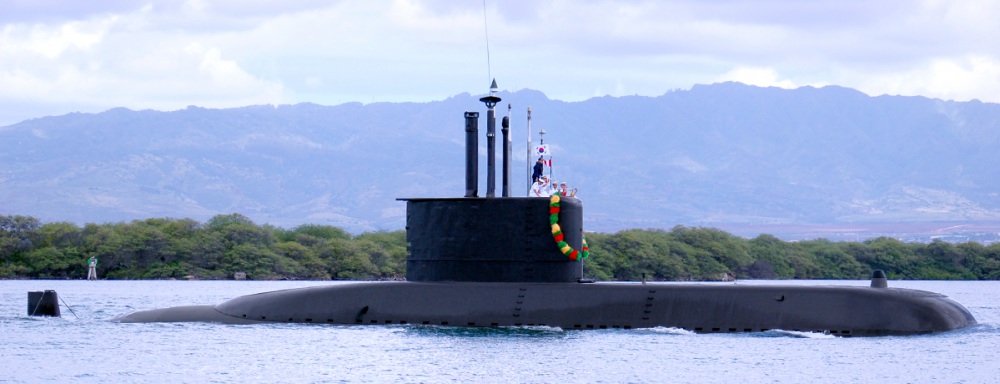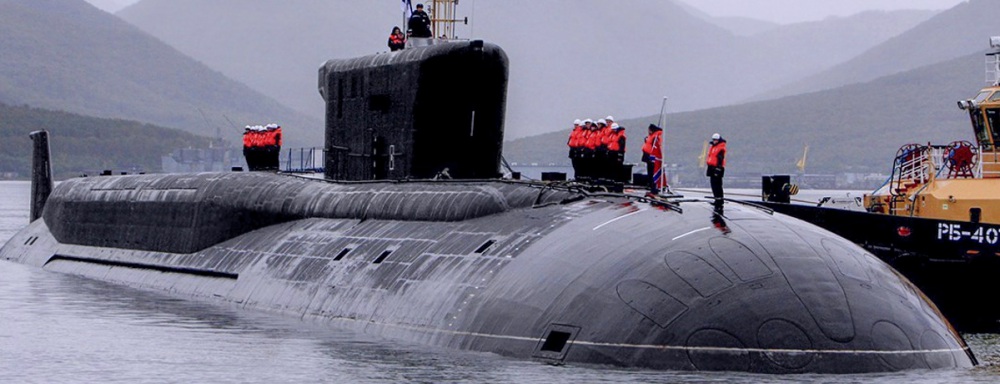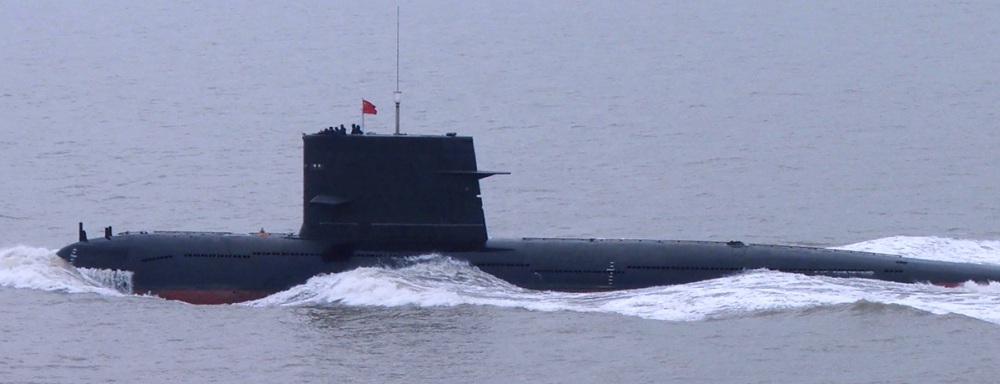
About the image
Capabilities at a Glance
The Republic of Korea Navy (ROKN) established a formal submarine command at Jinhae Naval Base on the southern coast of South Korea on 1 February 2015.1 The ROKN currently operates a submarine flotilla of nine diesel-electric Jang Bogo-class (Type 209/1200), seven Son Won II-class (Type 214) and one Dosan Ahn Changho-class hybrid diesel-electric/fuel cell vessels with air-independent propulsion (AIP).2
Total Submarines in Fleet: 19
- Ballistic Missile Submarines (SSBNs): 1
- Nuclear-Powered attack submarines (SSNs): 0
- Diesel-electric attack submarines (SSKs): 19
- Air-independent propulsion (AIP) enabled: 10/19
Submarines 3 4
History
Under license from Germany’s Howaldtswerke-Deutsche Werft (HDW), South Korea’s Hyundai Heavy Industries (HHI) and Daewoo Shipbuilding and Marine Engineering (DSME) produced the ROKN’s two submarine classes: Chang Bogo and Son Won II. Patterned off HDW’s Type 209 design, the Chang Bogo-class utilizes a diesel-electric powerplant and is armed with eight torpedo tubes. The first boat in the Chang Bogo class, ROKS Chang Bogo (061), was commissioned in 1993. Development of the Son Won II-class submarines, which integrate an advanced air-independent-propulsion system, began in 2000.5
Modernization and Current Capabilities
Procurement of the Chang Bogo (KSS-1) and Son Won II-class (KSS-2) submarines were part of the first two phases of South Korea’s three-phase submarine development plan. The ROKN launched an eighth Son Won-II-class vessel, ROKS Lee Beom-Seok, in November 2016. Then, in September 2017, they launched the ninth and final Son Won-II-class submarine: ROKS Sin Dol Seok.6
As part of the third phase of their development plan, the ROKN is in the process of adding nine Type 214 (KSS-3) vessels to its fleet. On 14 September 2018, the ROKN launched the first KSS-3 vessel: ROKS Dosahn Ahn Chango.7 In July 2019, it was reported that the Dosan Ahn Chang-ho started sea trials.8 The vessel was commissioned on 13 August 2021. 9 10 The KSS-3 submarine includes many upgrades, such as the capability to carry six vertical-launch tubes.11 The launch tubes will likely fit cruise missiles and a naval variant of South Korea’s Hyunmoo-2B ballistic missile, capable of striking targets within a 500km range.
In 2017, South Korean officials expressed interest in fitting KSS-3 submarines with a nuclear-powered propulsion unit.12 While the South Korean government has previously considered implementing nuclear propulsion for submarines, the Moon Administration denied plans to procure naval reactors in September 2017. Nonetheless, the ROK Navy reportedly commissioned a feasibility study on nuclear-powered options in October 2017.13
Ship Biographies
Chang Bogo-Class (Type 209/1200)
South Korea possesses nine Chang Bogo-class submarines. These submarines are 56 meters long with a 6.2-meter-wide beam and can travel up to 21.5 knots when submerged. They can remain submerged for about 50 days without surfacing. Their weapons systems are capable of firing torpedoes.14
Son Won-II-Class (Type 214)
South Korea possesses seven Son Won-II-class diesel-electric submarines. The Son Won-II-class is a hybrid diesel‐electric/fuel cell submarine with AIP technology. They are 65 meters long with a 6.3-meter-wide beam and can travel up to 20 knots when submerged. They can remain submerged for about 50 days without surfacing. Their weapons systems are capable of firing torpedoes and anti-ship missiles.
Dosan Ahn Chang-ho-Class15 16 17
South Korea possesses one Dosan Ahn Chang-ho-Class diesel-electric submarine. The Dosan Ahn Chang-ho-class is a hybrid diesel‐electric/fuel cell submarine with AIP technology. It is 83.3 meters long with a 9.6-meter-wide beam and can travel up to 20 knots when submerged. It can remain submerged for about 20 days without surfacing. Its weapons systems are capable of firing SLBMs, torpedoes, and naval mines.
Import and Export Behavior
Imports
South Korean shipbuilding companies Daewoo Shipbuilding and Marine Engineering (DSME) and Hyundai Heavy Industries (HHI) developed the ROKN’s submarines with support from Germany’s Howaldtswerke-Deutsche Werft (HDW).18 In March 2019, DSME and HHI announced their intentions to merge into one shipbuilding company.19
Exports
In 2003, South Korea and Indonesia signed a Memorandum of Understanding (MoU) on defense sector cooperation, agreeing to replace engines on Indonesia’s existing Type 209/1300 submarines.20 In 2011, South Korea outbid Russia, France, and Germany on a $1.1 billion tender to supply Indonesia with three Type 209-class submarines. The first two submarines of the class, KRI Nagapasa and KRI Ardadedali, were delivered to Indonesia in 2017 and 2018.21 The third submarine was assembled by Indonesian state-owned shipbuilder Perseroan Terbatas Penataran Angkatan Laut (PT-PAL) with South Korean support as part of a technology transfer program.22
Explore the Collection
Australia Submarine Capabilities
Brazil Submarine Capabilities
Chile Submarine Capabilities
China Submarine Capabilities
France Submarine Capabilities
Germany Submarine Capabilities
Greece Submarine Capabilities
India Submarine Capabilities
Indonesia Submarine Capabilities
Iran Submarine Capabilities
Israel Submarine Capabilities
Italy Submarine Capabilities
Japan Submarine Capabilities
Malaysia Submarine Capabilities
Netherlands Submarine Capabilities
North Korea Submarine Capabilities
Pakistan Submarine Capabilities
Russia Submarine Capabilities
Singapore Submarine Capabilities
Your are currently on
South Korea Submarine Capabilities
Sweden Submarine Capabilities
Taiwan Submarine Capabilities
United States Submarine Capabilities
Submarine Detection and Monitoring: Open-Source Tools and Technologies
Stay Informed
Sign up for our newsletter to get the latest on nuclear and biological threats.
More on

Russia Submarine Capabilities
Overview of Russia's submarine capabilities and import-export behavior.
United States Submarine Capabilities
Overview of the United States' submarine capabilities and import-export behavior.

China Submarine Capabilities
A highlight of global trends in the sale and acquisition of diesel- and nuclear-powered submarines by country with capabilities, imports and exports. (CNS)
Glossary
- SSBN
- Ship, Submersible, Ballistic, Nuclear: A hull classification for a submarine capable of launching a ballistic missile. The "N", or nuclear, refers to the ship's propulsion system. SSBN's are generally reserved for strategic vessels, as most submarine launched ballistic missiles carry nuclear payloads. A non-strategic vessel carries the designation SSN, or attack submarine.
- Diesel-electric submarine
- Diesel-electric submarine: A submarine with a diesel-electric transmission. Diesel-electric transmissions require access to oxygen for the diesel generator to charge the submarine’s batteries or drive the motor. This type of submarine is thus louder and must surface more frequently than a nuclear-powered submarine. A diesel-electric submarine can fire conventional cruise missiles against land targets, and in theory, can also carry nuclear-tipped cruise missiles. Diesel-electric submarines are significantly cheaper to build and purchase than nuclear-powered vessels, which makes them the vessel of choice for smaller navies.
- Air Independent Propulsion Technology (AIP)
- Air Independent Propulsion Technology (AIP): A propulsion system that uses liquid (or compressed) oxygen or hydrogen fuel cells, thereby allowing submarines to stay submerged for longer periods without the need for external sources of oxygen. This increased endurance also increases a submarine’s survivability.
- Cruise missile
- An unmanned self-propelled guided vehicle that sustains flight through aerodynamic lift for most of its flight path. There are subsonic and supersonic cruise missiles currently deployed in conventional and nuclear arsenals, while conventional hypersonic cruise missiles are currently in development. These can be launched from the air, submarines, or the ground. Although they carry smaller payloads, travel at slower speeds, and cover lesser ranges than ballistic missiles, cruise missiles can be programmed to travel along customized flight paths and to evade missile defense systems.
- Ballistic missile
- A delivery vehicle powered by a liquid or solid fueled rocket that primarily travels in a ballistic (free-fall) trajectory. The flight of a ballistic missile includes three phases: 1) boost phase, where the rocket generates thrust to launch the missile into flight; 2) midcourse phase, where the missile coasts in an arc under the influence of gravity; and 3) terminal phase, in which the missile descends towards its target. Ballistic missiles can be characterized by three key parameters - range, payload, and Circular Error Probable (CEP), or targeting precision. Ballistic missiles are primarily intended for use against ground targets.
Sources
- Jung Sung-Ki, “South Korea Focuses on Underwater Protection,” Defense News, 12 April 2015, www.defensenews.com; Ridzwan Rahmat, “South Korea to Establish ‘Submarine Operational Plan,’” IHS Jane’s 360, 12 February 2015, www.janes.com.
- “Submarine forces, Korea, South,” Jane’s Underwater Warfare Systems, 16 June 2011; Franz-Stefan Gady “South Korea Launches New ‘Strategic Dagger’ Attack Submarine,” The Diplomat, 8 September 2017, www.thediplomat.com.
- “잠수함,” 2016, https://www.navy.mil.kr.
- “손원일급 잠수함 - 나무위키,” 29 May 2022, https://namu.wiki.
- “Navy Launches 2nd 1,800-ton Submarine,” The Korea Times, 13 June 2007, www.koreatimes.co.kr; “Submarine forces, Korea, South,” Jane’s Underwater Warfare Systems, 16 June 2011.
- “South Korea launches eighth 1,800-ton submarine,” Yonhap News, 8 November 2016, www.english.yonhapnews.kr.
- Sebastien Roblin, “Are South Korean Submarines About to Go Nuclear?” The National Interest, 9 March 2019, https://nationalinterest.org.
- “Submarines: South Korean Super Subs,” Strategy Page: The News as History, 1 January 2021, www.strategypage.com.
- Min, Byeong-gwon. “최초의 순수 국산 잠수함 ‘도산안창호함’ 취역...SLBM 싣고 北·中 견제.” 서울경제. <em>Seoul Economy,</em> 13 August 2021, www.sedaily.com.
- Yoo, Yong-won. “국내 첫 SLBM 장착 ‘도산안창호함’ 취역… 국산화율 76%.” 조선일보. <em>Joseon Bulletin,</em> 13 August 2021, www.chosun.com.
- Yoon Min-Silk, “Navy Assembles First Homegrown Submarine,” The Korea Herald, 17 May 2016; “Keel Laying Ceremony for Jangbogo-III Submarine,” KBS World Radio, 17 May 2015.
- “Moon visits submarine command amid talks of nuclear-powered subs,” Yonhap News Agency, 3 August 2017, www.yonhapnews.co.kr; Franz-Stefan Gady, “Will South Korea build nuclear attack subs?” The Diplomat, 8 November 2017, www.thediplomat.com; Lami Kim, “South Korea’s Nuclear Hedging?” The Washington Quarterly 41, Issue 1 (Spring 2018), pp. 115-133.
- “S. Korea denies report on agreement with U.S. on nuclear-powered submarines,” Yonhap News Agency, 19 September 2017, www.yonhapnews.co.kr; Jeff Jeong, “South Korea eyes French design for indigenous nuclear sub, sources say,” Defense News, 28 March 2018, www.defensenews.com.
- “ROKN Chang Bogo Class Submarines,” Naval Technology, accessed 8 August 2019, www.naval-technology.com.
- “KSS-III (Jangbogo-III) Class Attack Submarines, South Korea,” Naval Technology, 21 January 2022, www.naval-technology.com.
- Kim, Soohan. “3000t급 잠수함 독자설계..한국, 5번째 잠수함 수출국 등극.” 8 October 2018, https://news.v.daum.net
- Dominguez, Gabriel, and Dae Young Kim. “HHI Launches Third KSS-III-Class Submarine for South Korean Navy,” Janes.com. 28 September 2021, www.janes.com.
- “Introduction,” The Market: Australasia and East Asia, Korea South, Jane’s Naval Construction and Retrofit Markets, 8 August 2003, No.18; “Südkorea will U-Boote von HDW bauen (South Korea wants to build submarines from HDW)” Deutsche Presse-Agentur, 3 November 2000.
- “South Korea: HHI Take over of DSME to Create Global Shipbuilding Giant,” Naval Today, 8 March 2019, https://navaltoday.com.
- “DPR agrees on procurement of more Sukhoi aircraft,” Kompas, 1 September 2003; “Indonesia: Navy Chief of Staff visits South Korea to sign MoU for new Navy,” FBIS Document SEP20030901000039.
- Prashanth Parameswaran, “Indonesia Gets a New Submarine from South Korea,” The Diplomat, 28 April 2018, www.thediplomat.com; Ridzwan Rahmat, “Indonesia to homeport newly commissioned Type 209/1400 submarine in Central Sulawesi,” Jane’s Navy International, 3 August 2017.
- “Indonesia Launches Thrid Nagapasa-Class Diesel Electric Attack Submarine,” The Diplomat, 11 April 2019, https://thediplomat.com.
Additional Sources
- “[알아봅시다]군함의 이름은 어떻게 붙일까?” Hyundai Heavy Industries Business Blog, September 12, 2017, http://blog.hhi.co.kr.
- Won-sang Chae, “첫 여성이름 붙인 잠수함 ‘유관순함’ 취역식,” 굿모닝충청 [Good Morning Choong Chung], July 12, 2017, www.goodmorningcc.com.
- Gabriel Dominguez and Dae Young Kim, “HHI Launches Third KSS-III-Class Submarine for South Korean Navy,” Janes, September 28, 2021, www.janes.com.
- “DSME Launched ROK Navy’s 1st 3000 Tons KSS-III Submarine Dosan Ahn Chang-Ho,” Navy Recognition, 2018, www.navyrecognition.com.
- Yoon-hyoung Gil, “첫 3000t급 잠수함 ‘도산안창호함’ 취역…불시에 적 타격 SLBM 탑재,” Hangyeorye, August 13, 2021, www.hani.co.kr.
- Yong-in Hwang, “손원일급 4번 잠수함 ‘김좌진함’ 취역,” 경남일보 – 우리나라 최초의 지역신문 [KyungNam Bulletin], January 4, 2015, www.gnnews.co.kr.
- “잠수함,” Navy.mil.kr, 2016, www.navy.mil.kr.
- Linda Kay, “South Korea Delivers 1,400-Ton Submarine to Indonesia,” Defense World, March 17, 2021, www.defenseworld.net.
- “해군 최신예 214급 잠수함 ‘정지함’ 취역,” KBS 뉴스 [KBS News], December 2, 2008, https://news.kbs.co.kr.
- Soohan Kim, “3000t급 잠수함 독자설계..한국, 5번째 잠수함 수출국 등극,” October 8, 2018, http://biz.heraldcorp.com.
- Soo-han Kim, “이화여고 학생들, 잠수함사령부 유관순함 방문,” 헤럴드경제 [Korean Herald (Economist)], February 22, 2019, http://news.heraldcorp.com.
- “KSS-III (Jangbogo-III) Class Attack Submarines, South Korea,” Naval Technology, January 21, 2022, www.naval-technology.com.
- “해군 잠수함 ‘홍범도함’ 취역,” 경남신문 [KyungNam Newspaper], January 24, 2018, http://m.knnews.co.kr.
- Jong-gu Lee, “한국 첫 214급 잠수함 ‘손원일함’ 취역,” 경남신문 [KyungNam Newspaper], December 28, 2007, www.knnews.co.kr.
- Sang-heon Lee, “최신예 잠수함 안중근함 내일 취역(종합),” 연합뉴스 [Yonhap News], November 30, 2009, www.yna.co.kr.
- Su-yeol Maeng, “윤봉길의사처럼 조국 바닷속 지킨다!” 국방일보 [Kookbang Bulletin], June 21, 2016, https://kookbang.dema.mil.kr.
- Byeong-gwon Min, “최초의 순수 국산 잠수함 ‘도산안창호함’ 취역…SLBM 싣고 北·中 견제,” 서울경제 [Seoul Economy], August 13, 2021, www.sedaily.com.
- Sung-jin Park, “1800t급 잠수함 ‘손원일함’ 28일 실전배치,” KyungHyang Newspaper, December 28, 2007, https://m.khan.co.kr.
- “손원일급 잠수함 – 나무위키,” Namu Wiki, May 29, 2022, https://namu.wiki.
- Kenichi Yamada, “South Korea Exports First Submarine,” Nikkei Asia, August 3, 2017, https://asia.nikkei.com.
- Yong-won Yoo, “국내 첫 SLBM 장착 ‘도산안창호함’ 취역… 국산화율 76%,” 조선일보 [Joseon Bulletin], August 13, 2021, www.chosun.com.
